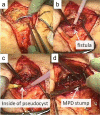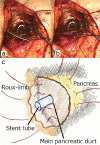Redo pancreaticojejunal anastomosis for late-onset complete pancreaticocutaneous fistula after pancreaticojejunostomy
- PMID: 35786384
- PMCID: PMC9252026
- DOI: 10.1186/s12957-022-02687-y
Redo pancreaticojejunal anastomosis for late-onset complete pancreaticocutaneous fistula after pancreaticojejunostomy
Abstract
Background: Pancreaticojejunal (PJ) anastomosis occasionally fails several months after pancreaticoduodenectomy (PD) with Child reconstruction and can ultimately result in a late-onset complete pancreaticocutaneous fistula (Lc-PF). Since the remnant pancreas is an isolated segment, surgical intervention is necessary to create internal drainage for the pancreatic juice; however, surgery at the previous PJ anastomosis site is technically challenging even for experienced surgeons. Here we describe a simple surgical procedure for Lc-PF, termed redo PJ anastomosis, which was developed at our facility. METHODS: Between January 2008 and December 2020, six consecutive patients with Lc-PF after PD underwent a redo PJ anastomosis, and the short- and long-term clinical outcomes have been evaluated. The abdominal cavity is carefully dissected through a 10-cm midline skin incision, and the PJ anastomosis site is identified using a percutaneous drain through the fistula tract as a guide, along with the main pancreatic duct (MPD) stump on the pancreatic stump. Next, the pancreatic stump is deliberately immobilized from the dorsal plane to prevent injury to the underlying major vessels. After fixing a stent tube to both the MPD and the Roux-limb using two-sided purse-string sutures, the redo PJ anastomosis is completed using single-layer interrupted sutures. Full-thickness pancreatic sutures are deliberately avoided by passing the needle through only two-thirds of the anterior side of the pancreatic stump.
Results: The redo PJ anastomosis was performed without any intraoperative complications in all cases. The median intraoperative bleeding and operative time were 71 (range 10-137) mL and 123 (range 56-175) min, respectively. Even though a new mild pancreatic fistula developed postoperatively in all cases, it could be conservatively treated within 3 weeks, and no other postoperative complications were recorded. During the median follow-up period of 92 (range 12-112) months, no complications at the redo PJ anastomosis site were observed.
Conclusions: This research shows that the redo PJ anastomosis for Lc-PF we developed is a safe, feasible, and technically no demanding procedure with acceptable short- and long-term clinical outcomes. This procedure has the potential to become the preferred treatment strategy for Lc-PF after PD.
Keywords: Pancreatic fistula; Pancreaticoduodenectomy; Pancreaticojejunostomy.
© 2022. The Author(s).
Conflict of interest statement
The authors declare that they have no competing interests.
Figures



Similar articles
-
Pancreaticojejunostomy versus controlled pancreaticocutaneous fistula in pancreaticoduodenectomy for periampullary carcinoma.Am J Surg. 1995 Jun;169(6):585-8. doi: 10.1016/s0002-9610(99)80226-8. Am J Surg. 1995. PMID: 7771621 Clinical Trial.
-
A duct-to-mucosa pancreaticojejunostomy for small main pancreatic duct and soft pancreas in minimally invasive pancreaticoduodenectomy.Surg Endosc. 2023 May;37(5):3567-3579. doi: 10.1007/s00464-022-09830-6. Epub 2023 Jan 9. Surg Endosc. 2023. PMID: 36624217 Free PMC article.
-
Pancreas-preserving management of grade-C pancreatic fistula and a novel bridging technique for repeat pancreaticojejunostomy: An observational study.Int J Surg. 2018 Apr;52:243-247. doi: 10.1016/j.ijsu.2018.02.026. Epub 2018 Feb 17. Int J Surg. 2018. PMID: 29462737
-
[Complications of two types of pancreatic anastomosis after pancreaticoduodenectomy].Ann Chir. 1996;50(6):431-7. Ann Chir. 1996. PMID: 8991198 Review. French.
-
Pancreaticojejunostomy Conducive to Biological Healing in Minimally Invasive Pancreaticoduodenectomy.J Gastrointest Surg. 2022 Sep;26(9):1967-1981. doi: 10.1007/s11605-022-05339-4. Epub 2022 May 11. J Gastrointest Surg. 2022. PMID: 35546220 Free PMC article. Review.
Cited by
-
Treatment of delayed pancreatic fistula associated with anastomosis breakdown after pancreaticoduodenectomy using percutaneous interventions.Clin J Gastroenterol. 2024 Apr;17(2):356-362. doi: 10.1007/s12328-023-01900-z. Epub 2023 Dec 18. Clin J Gastroenterol. 2024. PMID: 38108998
References
MeSH terms
LinkOut - more resources
Full Text Sources
Medical

